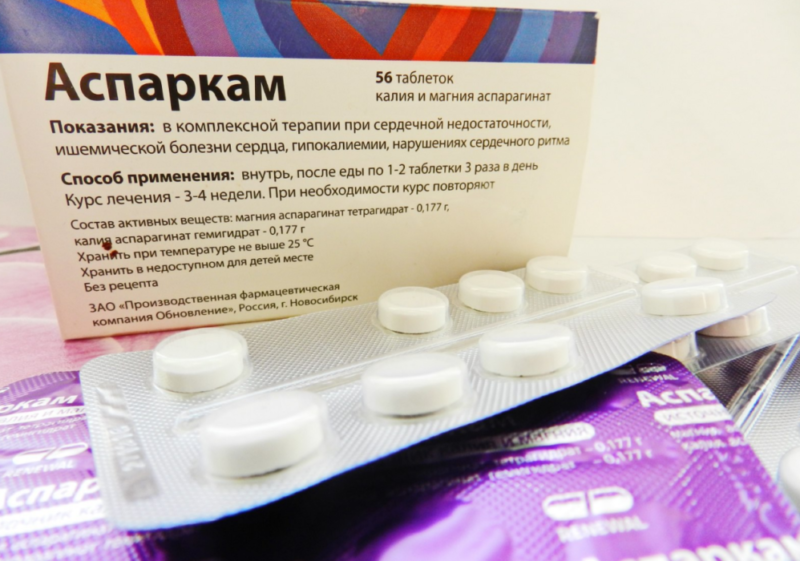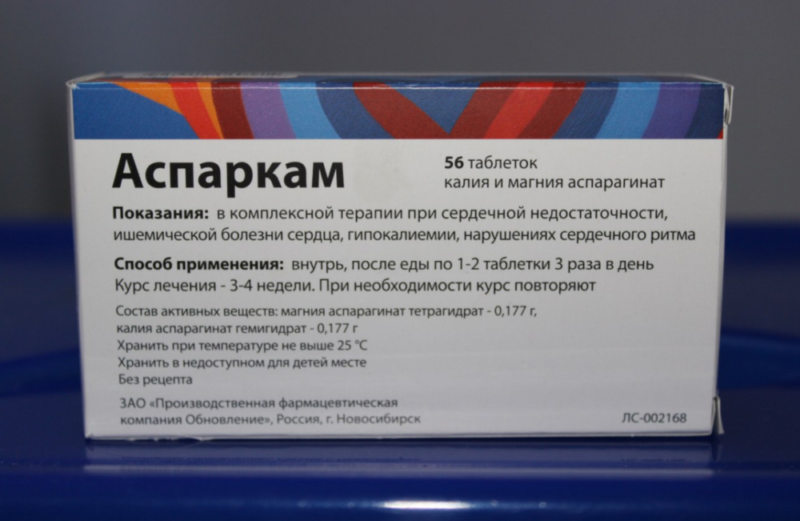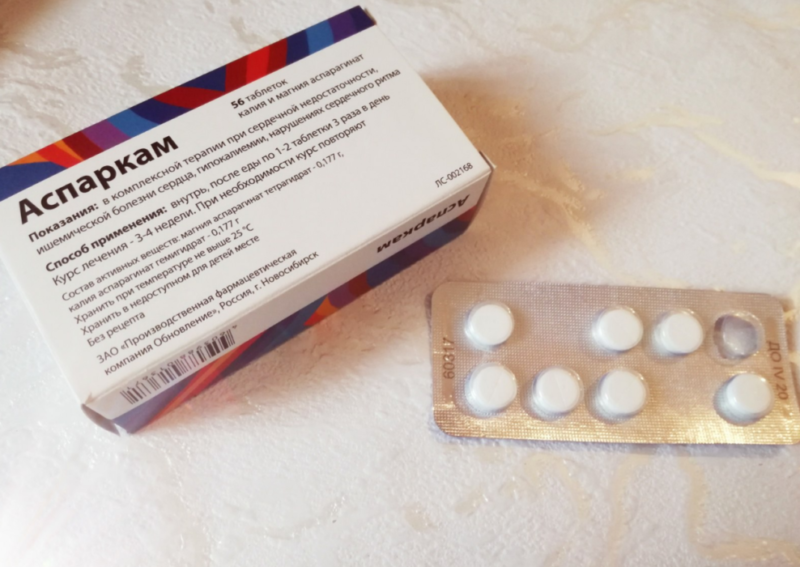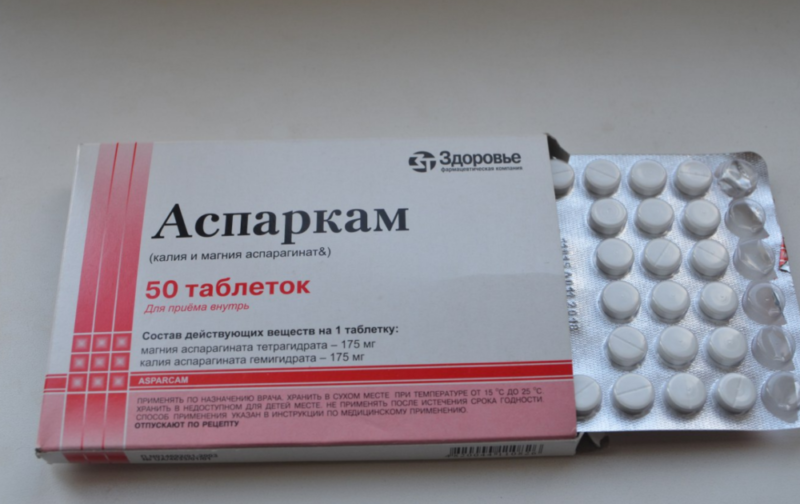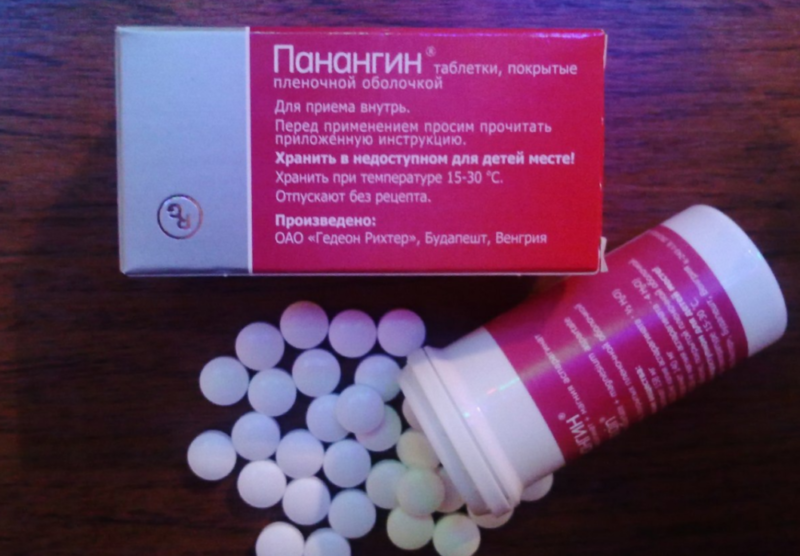Normal cardiac activity is largely ensured by potassium and magnesium. The lack of these elements is manifested by arrhythmia and angina pectoris. Asparkam tablets are a kind of vitamins for the heart, which restore the electrolyte balance in the tissues, and also serve as a means of preventing stroke.
Material Content:
- 1 The composition of the drug
- 2 Pharmacological action and pharmacokinetics
- 3 In what cases are Asparkam tablets prescribed
- 4 Instructions for use and dosage
- 5 During pregnancy and lactation
- 6 Drug interaction
- 7 Alcohol compatibility
- 8 Contraindications and side effects
- 9 Similar preparations containing potassium and magnesium
The composition of the drug
Potassium and magnesium are regulators of metabolic processes that ensure normal contractility of smooth tissues. Cells consume these elements in the form of ions.
The composition of the tablet substance is in the form of a complex salt - in equal amounts of potassium asparaginate and magnesium asparaginate (175 mg each). In the process of assimilation, asparaginate easily decomposes into metal ions and aspartate, which, in turn, provides easy penetration of ions into the space between cells.
The adsorption of the substance is provided by starch and stearic acid. Some manufacturers may add talc, macrogol, povidone, as well as change potato starch to corn.
Most companies produce tablets in the form of flat white cylinders with a rough surface, a specific smell and a dividing strip. Among the packages there are blisters and polymer cans. The shelf life of the drug is no more than three years.
Pharmacological action and pharmacokinetics
Mineral supplement serves as an additional source of electrolytes.
Metal ions are involved in metabolic reactions, restore lost nerve connections, relax the heart muscle and normalize the rhythm of its work.
The medicine is absorbed almost in full. Peak serum concentrations are established within two hours. The metabolites of the starting substances are rapidly and fully excreted by the kidneys.
In blood, asparaginate breaks down into electrolyte ions and carrier molecules. Aspartate provides transport of potassium and magnesium to tissues, where they are integrated into the reaction chain.
Potassium provides the conductivity of nerve fibers, establishes a connection between nerve cells, is involved in the transmission of an electrical impulse to muscle fibers. It provides contractility of smooth muscle tissue, maintains normal vascular tone.
Magnesium activates more than 300 enzymes that trigger metabolism. It maintains the electrolytic balance, enters into the structure of DNA and RNA, is responsible for the intake and expenditure of energy, cell division and growth, and helps potassium ions to penetrate the cell membrane.
The mineral supplement reduces the concentration of sodium in the intercellular space, inhibits the entry of calcium into the cells, and relaxes the smooth muscles of the heart and blood vessel walls. It has a mild antiarrhythmic effect, and also protects the myocardium from the effects of cardiac glycosides.
In what cases are Asparkam tablets prescribed
As a single drug, the drug is prescribed to replenish the reserves of ions with hypokalemia and hypomagnesemia, which developed against the background of prolonged treatment with diuretics. Lack of potassium and magnesium may be associated with diarrhea, repeated vomiting or laxatives.
In complex therapy, the additive is used to reduce the excitability of the heart muscle and improve energy exchange:
- in the post-infarction period;
- with coronary heart disease;
- during treatment of chronic heart failure.
Taking Asparkam reduces the likelihood of death due to a stroke.
Tablets are prescribed to eliminate arrhythmia against the background of a violation of ion exchange, as well as to restore cardiac function after an overdose of glycosides.
In some cases, Asparkam is prescribed to people engaged in increased physical exertion. Athletes may develop potassium deficiency while eating high-protein foods, as well as as a result of its loss during excretion with sweat during strength training.
A micronutrient deficiency is manifested by a decrease in muscle performance, convulsions and a disturbance in the rhythm of the heart. To compensate for the deficiency, a mineral complex is prescribed, which improves the condition of the heart muscle and increases its resistance to increased loads.
Instructions for use and dosage
The dose for the treatment of severe micronutrient deficiency is 2 tablets. They are taken three times a day for three weeks. If necessary, the course is extended to a month. After a break, treatment can be repeated.
To prevent strokes and heart diseases with a decrease in the concentration of potassium in the blood and the presence of characteristic symptoms (heart palpitations, muscle weakness, pain behind the sternum), they take one tablet in the morning, afternoon and evening. The duration of prevention is determined by the doctor.
Dragees are better absorbed after eating. The dosages presented in the instructions apply only to adults. For children, standards are not provided.
However, in pediatrics there is experience using this complex tool.
Children are prescribed an additive if there are signs of a lack of elements:
- hypokalemia detected by blood tests;
- decreased muscle tone;
- drowsiness and lethargy;
- low blood pressure;
- interruptions in heart rate.
In infants, hypokalemia is accompanied by prolonged diarrhea, frequent vomiting, decreased renal function and complications of the digestive tract.However, indications for use should be confirmed by blood tests.
Infants up to 12 months of age are given a quarter of a tablet once a day. By three years, a single and daily dose is increased to half the dragee. At six years old, the same norm can be taken already in the morning and in the evening. And after seven and up to ten years, the same amount is allowed to drink three times a day.
From eleven to sixteen years, a single tablet becomes a single dose. Dragees are drunk either once or twice a day. From the age of sixteen they switch to a three-time appointment. And after eighteen, the treatment looks like in adults.
During pregnancy and lactation
In order to avoid a shift in the electrolyte balance, Asparkam is not prescribed for pregnant women for prevention. Such prescriptions are made only in medicinal whole. The doctor may supplement the administration of Furosemide diuretic with Asparkam if pregnancy is accompanied by high blood pressure and edema.
The appointment is justified by the fact that, together with urine, a significant amount of potassium leaves the body. In order to prevent its deficiency, a mineral supplement is prescribed.
With frequent diarrhea or repeated vomiting, a pregnant woman may recommend taking these tablets to make up for electrolyte loss. As a rule, rehabilitation therapy lasts no longer than seven days.
During breastfeeding, the appointment of Asparkam is decided on an individual basis. Lactation and pregnancy are not included in the list of contraindications, but relate to special conditions.
Drug interaction
The combination of the drug with potassium-sparing drugs is undesirable, since this can lead to an excess of electrolytes and, against this background, cause arrhythmia.
These tools include:
- non-steroidal anti-inflammatory;
- heparin;
- triamterene, spironolactone;
- cyclosporine;
- ACE inhibitors;
- cardiac adrenaline receptor blockers.
However, when combined with glucocorticosteroids and cardiac glycosides, the opposite effect is observed. Adding Asparkam eliminates the negative reaction to drugs belonging to these groups.
Tetracycline, streptomycin and neomycin lose their effectiveness against the background of the drug, and depolarizing muscle relaxants, on the contrary, reveal their potential.
Calcium-containing preparations are antagonists of the mineral supplement. The benefits of magnesium are lost with calcium.
Enveloping gastric agents and adsorbents reduce the absorption of dragees. After them you need to wait at least three hours.
Alcohol compatibility
The mineral complex does not form a toxic combination with alcohol. And on the one hand, such a combination is possible, but the result depends on what purpose and at what time Asparkam is used.
If the tablets are drunk according to the indications, then alcohol can weaken their positive effect. This is due to the fact that alcoholic beverages intensively remove water from the body along with useful elements - potassium and magnesium.
At the same time, taking Asparkam as a remedy for a hangover can give a positive result. It will replenish the reserves of lost electrolytes and improve well-being.
Contraindications and side effects
The balance of electrolytes is maintained in the body by strict concentrations of substances. Any shifts lead to disruption of metabolic processes. Therefore, Asparkam should not be taken in tablets, having problems that interfere with the normal absorption and excretion of electrolytes.
Among them:
- severe renal impairment;
- blockade of the electrical signal from the atrium to the ventricle;
- excess serum potassium and magnesium ions;
- autoimmune muscle weakness;
- blood system diseases.
The appointment of Asparkam is prevented by intolerance of the components of the dragee, as well as low systolic pressure (less than 90 mm Hg).
The reaction to potassium and magnesium may go in the wrong direction.In this case, the patient will feel discomfort from the gastrointestinal tract, including nausea and burning in the pancreas. Intolerance is sometimes expressed by vomiting and diarrhea, a heart rhythm disorder with repeated extrasystoles (strong and sharp strokes), a drop in pressure, physical weakness and redness of the face.
Coma and anaphylactic shock mean extreme rejection. Rarely, treatment can end not with restoration, but with a violation of the electrolyte balance with the development of hyperkalemia and hypermagnesemia. A similar reaction indicates a probable overdose and the need for the introduction of calcium preparations, hemodialysis.
Similar preparations containing potassium and magnesium
If you enter a query about analogues of Asparkam, then the name “Panangin” will most often be found in the search results. This is the only analogue of the drug in question, although it can not be considered a complete synonym.
The composition of Asparkam tablets differs from the Panangin formula not only in secondary components, but also in the concentration of active substances. If the magnesium content in them is identical, then the potassium compounds in the analog are less (instead of 175 mg - 166.3 mg).
The difference lies in the fact that a similar preparation has a film coating that protects the tooth enamel and stomach from the action of the active components. The effect of both drugs is the same, but with respect to Panangin fewer complaints of adverse reactions.
Almost any expensive tool can find an affordable analogue. The Asparkam tablets considered in the article are in no way inferior in terms of medicinal properties to the widely advertised Panangin.


